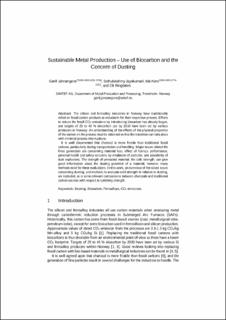| dc.contributor.author | Jahrsengene, Gøril | |
| dc.contributor.author | Jayakumari, Sethulakshmy | |
| dc.contributor.author | Kero, Ida Teresia | |
| dc.contributor.author | Ringdalen, Eli | |
| dc.date.accessioned | 2024-02-14T09:28:14Z | |
| dc.date.available | 2024-02-14T09:28:14Z | |
| dc.date.created | 2023-12-08T08:29:27Z | |
| dc.date.issued | 2023 | |
| dc.identifier.citation | Proceedings of the 62nd Conference of Metallurgists, COM 2023. Springer, Cham, 1001-1007. | en_US |
| dc.identifier.isbn | 978-3-031-38140-9 | |
| dc.identifier.uri | https://hdl.handle.net/11250/3117418 | |
| dc.description.abstract | The silicon and ferroalloy industries in Norway have traditionally relied on fossil carbon products as reductants for their respective process. Efforts to reduce fossil CO2 emissions by introducing biocarbon have already begun, and targets of 25–40% biocarbon use by 2030 have been set by various producers in Norway. An understanding of the effects of the physical properties of the carbon on the process must be obtained so that the transition can take place with minimal process interruptions. It is well documented that charcoal is more friable than traditional fossil carbons, particularly during transportation and handling. Major issues related to the fines generation are concerning material loss, effect of furnace performance, personal health and safety concerns by inhalation of particles, and possibility of dust explosions. The strength of unreacted material, the cold strength, can give good information about the dusting potential of a material; however, many methods exist for these evaluations. In this work, an overview of the raised issues concerning dusting, and methods to evaluate cold strength in relation to dusting, is included, as is some relevant comparisons between charcoals and traditional carbon sources with respect to tumbling strength. | en_US |
| dc.language.iso | eng | en_US |
| dc.publisher | Springer | en_US |
| dc.relation.ispartof | Proceedings of the 62nd Conference of Metallurgists, COM 2023, Toronto, Canada | |
| dc.rights | Navngivelse 4.0 Internasjonal | * |
| dc.rights.uri | http://creativecommons.org/licenses/by/4.0/deed.no | * |
| dc.title | Sustainable Metal Production: Use of Biocarbon and the Concern of Dusting | en_US |
| dc.title.alternative | Sustainable Metal Production: Use of Biocarbon and the Concern of Dusting | en_US |
| dc.type | Chapter | en_US |
| dc.description.version | acceptedVersion | en_US |
| dc.rights.holder | © 2023 The Author(s), under exclusive license to Springer Nature Switzerland AG. | en_US |
| dc.source.pagenumber | 1001-1007 | en_US |
| dc.identifier.doi | 10.1007/978-3-031-38141-6_126 | |
| dc.identifier.cristin | 2210738 | |
| dc.relation.project | Norges forskningsråd: 280968 | en_US |
| dc.relation.project | Norges forskningsråd: 294679 | en_US |
| dc.relation.project | Norges forskningsråd: 336309 | en_US |
| cristin.ispublished | true | |
| cristin.fulltext | postprint | |
| cristin.qualitycode | 1 | |

